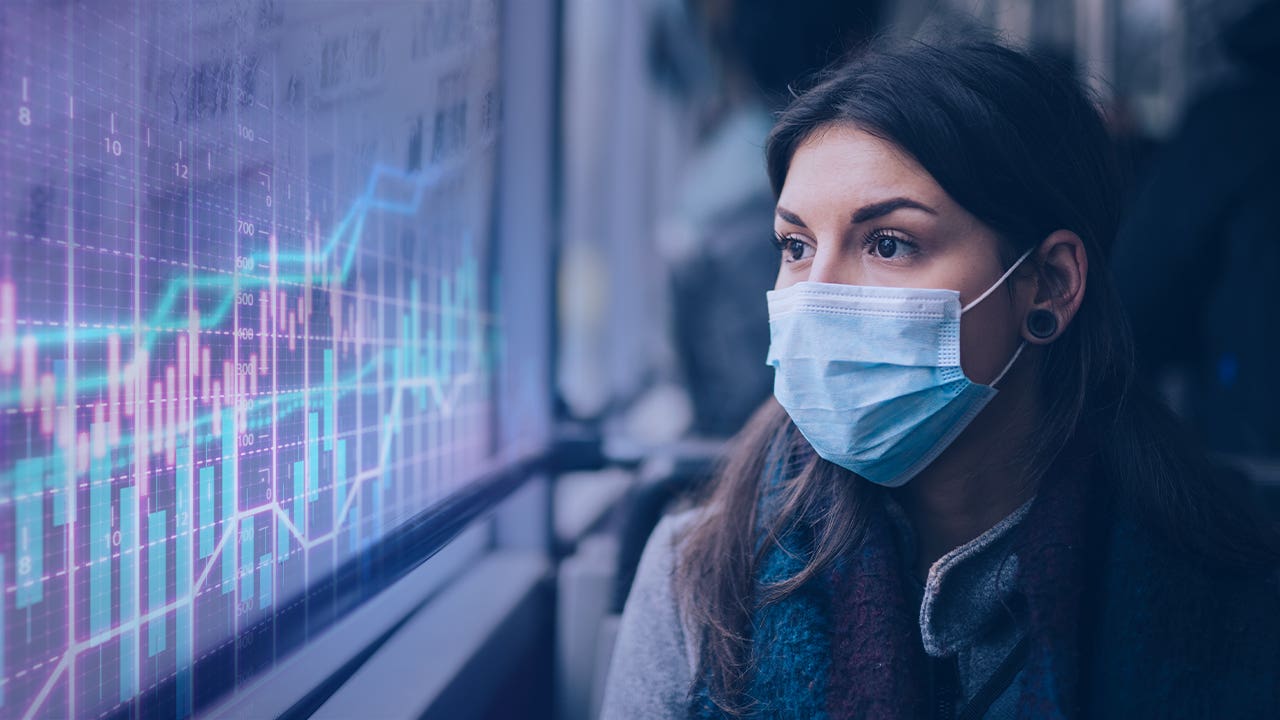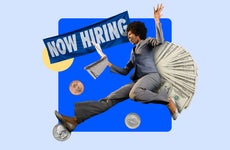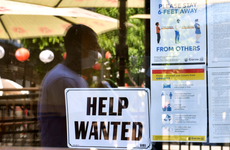Survey: Top economists see elevated COVID-19 joblessness for at least another year

The Bankrate promise
At Bankrate we strive to help you make smarter financial decisions. While we adhere to strict , this post may contain references to products from our partners. Here's an explanation for .
The U.S. economy is piecing itself back together more than a year after it was shattered by the coronavirus outbreak. But brighter economic expectations could also be a turning point for consumers’ personal finances post-pandemic, according to the nation’s top economists.
Along with a recovering job market and faster hiring, experts polled in Bankrate’s First-Quarter Economic Indicator survey see a key benchmark for home-buying costs continually edging up over the next 12 months. And while the majority (81 percent) see the Fed holding interest rates at their rock-bottom levels over the next year, a growing number (19 percent, versus none in the prior survey period) also say a Fed interest rate hike is possible over the same time frame, which would be sooner than policymakers themselves are expecting.
That stronger economic backdrop could help lift up prices more significantly than expected over the next 12 months, 2 in 5 experts (or 38 percent) say, bucking the trend from the last economic expansion when inflation remained subdued during the recovery.
“As we’ve learned over the challenging past year, the economy seldom unfolds exactly as expected, and sometimes takes a sharp turn,” says Mark Hamrick, Bankrate senior economic analyst and Washington bureau chief. “But if things unfold over the next year or so as largely expected, Americans’ personal finances should benefit, amid further healing of the job market in a low interest rate environment.”
Below are the findings from Bankrate’s survey, which polled 21 economists between March 3 and March 11 on where they see unemployment, job creation, interest rates and the broader economic outlook heading over the next 12 months.
Key takeaways:
- Economists see unemployment a year from now falling more than a percentage point to 5.1 percent.
- Experts see the U.S. economy adding an average of roughly 376,000 new positions each month over the next 12 months.
- Most economists (81 percent) say the Fed won’t move interest rates from near-zero, though a larger proportion than previous survey periods say the Fed’s next move will be a rate hike.
- Forecasters predict that the 10-year Treasury yield will rise to 1.84 percent a year from now.
- Economists are nearly split on whether inflation will be largely as expected or more significant than expected (43 percent versus 38 percent, respectively).
- Majority of economists (62 percent) say risks are tilted toward the upside over the next 12-18 months.
Economists see job market rebound picking up, though still above pre-pandemic levels
The U.S. labor market nearly collapsed when the coronavirus pandemic first forced government officials to shut down cities and states to curb the contagion’s spread. Employers cut 22.2 million positions between February and April of last year. Joblessness soared, with alternative measures beyond the headline number suggesting more than 20 percent of the labor force remained out of work. Almost a quarter of the labor force applied for unemployment benefits.
Employers between last May and August recovered roughly half of the positions that were cut. But the pace of that rebound soon slowed, with employers retracting positions in a pivotal December 2020 month.
Then came a supplemental $900 billion coronavirus relief package, passed in the final days of former President Donald Trump’s administration that sent a second $600 (or more) stimulus check to eligible U.S. adults and their dependents. The package also revived forgivable small business loans through the Paycheck Protection Program (PPP) and ramped up unemployment benefits at an extra $300 a week.
By March 11, President Joe Biden signed his $1.9 trillion American Rescue Package into law, sending a third round of stimulus checks worth $1,400, ramping up unemployment benefits and boosting vaccine supply and distribution at a crucial inflection point for the pandemic.
Those packages have played a role in considerably brightening economists’ expectations for growth over the next 12 months. Experts predict that the nation’s unemployment rate will slide to 5.1 percent one year from now, suggesting a 1.1 percentage point drop from its current level of 6.2 percent in February. That compares with forecasts of 6 percent in a December 2020 iteration of the economists’ survey, 7 percent in an October poll and 10 percent from back in June.
Forecasts also range from as low as 4.1 percent to as high as 6.5 percent. More than half (52 percent) see a jobless rate of 5 percent or lower 12 months from now.
Economists were on the same page as U.S. central bankers when they submitted their forecasts. Fed officials in a December projection, the latest for which data was available at the time of the poll, showed unemployment falling to 5 percent by the end of 2021. Those projections have since been updated at the Fed’s March meeting, showing an even more optimistic labor market outlook: 4.5 percent joblessness by the end of 2021.
“A pickup in vaccinations, reduced COVID-related restrictions, and the possibility of surging consumer demand fueled by excess savings and fiscal stimulus are all positives for the labor market looking ahead,” says Odeta Kushi, deputy chief economist at First American Financial Corporation. “We’re not out of the woods yet, but the green shoots of recovery are beginning to sprout.”
Experts see faster pace of U.S. hiring
Helping to reduce joblessness is a faster pace of U.S. hiring, which economists see occurring at an average pace of 376,000 each month for the next 12 months. If that pace were to come to fruition, the U.S. economy will have recovered 78 percent of all 22.2 million jobs lost during the pandemic a year from now. Forecasts also range from 179,000 a month for the next year to a whopping 565,000 per month. The average forecast for job gains in the fourth quarter survey was 321,000.
“The benefits of a stronger economy in 2021 will lead to greater employment growth,” says Gregory Daco, chief economist at Oxford Economics, whose forecast called for an average monthly job gain of 550,000. “We anticipate the economy will add seven million jobs in 2021, bringing the unemployment rate down below 5 percent by year end.”
However, economists aren’t anticipating a quicker employment rebound due to longer-run changes in the labor market. About 41 percent of the total unemployed have been jobless for 27 weeks or more, potentially leading to labor market scarring with workers at risk of losing skills the longer they remain out of a job.
Meanwhile, the industries most affected by the virus such as food service or retail will take the longest to recover, but changes in the way consumers spend their money might threaten the likelihood that all service-sector work comes back. Economists are also expecting that more workers will work fully remote post-pandemic, which could pose challenges for corners of the labor market that intersect, such as commercial real estate or clerical positions.
“In the second and third quarters of 2021, faster vaccine distribution and administration could provide a more robust reopening of the economy, when we expect employment to regain momentum,” says Yelena Maleyev, economist at Grant Thornton. “We are still 9.5 million jobs in the hole compared to a year ago. The Federal Reserve has taken notice.”
Most say Fed won’t move rates over the next year, though growing number predict a rate hike
U.S. central bankers have made no plans to bring interest rates back up from their historic lows anytime soon and are cautioning businesses, consumers and market participants that they don’t see interest rates rising through at least 2023. That’s according to fresh projections from the Fed’s March meeting, as well as congressional testimonies from Fed Chairman Jerome Powell himself.
Among the margin of Fed officials, however, some are already starting to pencil in rate increases. Four out of 18 total Fed officials see at least one rate hike in 2022, while three more see at least one hike in 2023.
One such official may be Dallas Fed President Robert Kaplan, who indicated in a March speech that he thinks the economy will be strong enough by 2022 to warrant raising short-term interest rates.
Even though the Fed hadn’t yet released those March projections by the time Bankrate’s poll closed, experts mimicked those forecasts. The majority (81 percent) see the Fed holding interest rates steady at their rock-bottom levels for the next 12 months, time reserved for giving the labor market and economy ample time to heal.
“The Fed is going to be patient,” says Ryan Sweet, senior director of real-time economics at Moody’s Analytics. “They will not hike rates just because the unemployment rate is dropping quickly. They are going to wait until they are staring at the whites of inflation’s eyes before raising interest rates.”
However, a growing number of experts (19 percent) say the Fed’s next move over the next year will be an interest rate increase. No expert saw that outcome in Bankrate’s fourth-quarter iteration of the economists’ poll.
“The Fed could be put on the spot to hike rates sooner, even as soon as later this year,” according to Robert Brusca, chief economist at Fact and Opinion Economics. “The stimulus program is going to push some distortions especially through the goods sector. It will not be an effective jobs creator until people are willing to engage in face-to-face transactions.”
Forecasters predict that the 10-year Treasury yield will keep rising
The Fed, however, mainly controls short-term interest rates, such as credit card and auto loan financing. The benchmark for the 30-year fixed rate mortgage is the 10-year Treasury yield, which has dramatically increased over the past six months as the economic outlook improves.
In fact, chaos in late February and early March erupted in the Treasury market after the 10-year rate swiftly surged back to levels not observed since before the COVID-19 pandemic. The fear is that the market messiness could stifle borrowing and business investment by lifting up mortgage rates and other borrowing costs. The swift spike has already pushed up the 10-year almost 80 basis points from the start of 2021 and more than a percentage point from a year ago, though the interest rate still remains not far from historic lows.
Fed officials have so far indicated that they are not concerned by the pick up in yields, talking down expectations that the U.S. central bank could deploy more asset purchases or more unconventional policies to keep borrowing rates in check.
Economists surveyed see that trend continuing, though not at the pace that the yield is currently tracking, even with expectations for a stronger job market. The average forecast is for a 1.84 percent yield 12 months from now, with those forecasts ranging from 1.45 percent to 2.25 percent. Eight of the 21 participants look for a yield of 2 percent or higher a year into the future. The benchmark yield stood at 1.53 percent at the time of the survey’s close. Notably, just three participants are predicting that the yield will decline.
Economists’ expectations for the 10-year Treasury have also risen survey by survey. The average forecast among respondents in the fourth quarter showed the 10-year Treasury yield at 1.25 percent a year down the road, with the previous third and second quarter averages below 1 percent. In the first quarter of 2020, right on the heels of the initial pandemic shock, the average forecast called for a 10-year yield of 1.83 percent 12 months into the future, indicating that the key rate might be normalizing as the economy improves.
Economists divided on outlook for inflation
Part of that story for the rising 10-year Treasury yield is the expectation that the U.S. economy could see price increases this year, thanks to the largest supply of money in history and one of the most aggressive recession responses from the federal government in generations.
Officials at the U.S. central bank have echoed that they see those price increases as being more temporary in nature rather than sustained, a byproduct of the pandemic that sent inflation to its lowest annual increases in years.
Economists, however, are divided on the inflationary outlook. Slightly more than two-fifths (43 percent) say inflation will be largely as expected over the next 12 months.
“Reflation will expectedly pick up as the lows of 2020 fall out of the equation,” says Lindsey Piegza, chief economist at Stifel. “Medium-term, however, weakness in the recovery and consumer is likely to keep inflation under control before longer-term aggressive government spending will lead inflation to push significantly higher.”
Another 38 percent, however, see price pressures being more significant than expected. Just 14 percent said it would be less than expected, while one respondent indicated any price increases would be more of a short-term issue, rather than a long-term concern.
“The Federal Reserve’s aggressive actions to counter the recession have pumped large amounts of reserves into the banks,” says Lynn Reaser, chief economist at Point Loma Nazarene University. “These could be tinder for higher inflation if spending and borrowing outpace the economy’s growth in capacity.”
Majority of economists say risks are tilted toward the upside over the next 12-18 months
But perhaps the most important takeaway for consumers: Economists are their most upbeat yet when it comes to assessing the balance of risks facing the U.S. financial system over the next 12 to 18 months.
More than three-fifths (or 62 percent) said the risks were tilted toward the upside, up considerably from the 50 percent of economists who said in both the fourth and third quarter of 2020 that the U.S. economy was facing more reasons for optimism than pessimism.
About 1 in 5 economists (or 19 percent) said risks were to the downside, while another 19 percent said risks were evenly balanced.
“Pent-up demand, flush household balance sheets, wide-spread vaccinations and more coronavirus relief from Washington tilt growth risks to the upside,” says Scott Anderson, executive vice president and chief economist at Bank of the West.
What this means for you
Although the pandemic-induced recession was nowhere near the length of the Great Recession, many Americans might fret at the thought of interest rates rising. Prioritize paying off high-cost debt, such as credit card balances, as interest rates remain low. Yet, borrowing costs will still remain near historically low levels, boding well for your chances of getting a loan for cheap if you’re still thinking about making a big-ticket purchase.
If you’re worried about inflation, experts don’t recommend changing your investment strategy all that much, but be sure you incorporate a diversified portfolio that includes an array of investment types, from certificates of deposit (CDs) and bonds to stocks and physical assets.
After ramping up their savings and receiving three stimulus checks, consumers might feel tempted to spend that extra money on the activities that were all but off limits during the pandemic, such as travel, shopping or dining out.
However, approach any discretionary expenses with caution, being sure that you have ample cash in a liquid and accessible account to cover your emergencies. The hardship from the coronavirus pandemic could persist for many months, particularly with lower-wage workers bearing the brunt of the pain. Reach out to any lenders that you regularly pay a bill to if you need financial assistance, and utilize any federal forbearance programs if you’re needing to free up extra cash.
“If the economy improves as many expect, it will remain to be seen whether deep divides involving wealth and income inequality can be bridged,” Hamrick says. “Our advice for individuals who can do it would be to focus on long-term goals, such as saving for emergencies and for retirement and to pay down debt. The quick and steep economic downturn of a year ago demonstrated that having sufficient savings really makes a huge and positive difference.”
Methodology
The First-Quarter 2021 Bankrate Economic Indicator Survey of economists was conducted March 8-11. Survey requests were emailed to economists nationwide, and responses were submitted voluntarily online. Responding were: Scott Anderson, executive vice president and chief economist, Bank of the West; Scott J. Brown, chief economist, Raymond James Financial; Ryan Sweet, director of real-time economics, Moody’s Analytics; John E. Silvia, president, Dynamic Economic Strategy; Gregory Daco, chief U.S. economist, Oxford Economics; Mike Fratantoni, chief economist, Mortgage Bankers Association; Yelena Maleyev, associate economist, Grant Thornton LLP; Lindsey Piegza, Ph.D., chief economist, Stifel; Lynn Reaser, chief economist, Point Loma Nazarene University; Joel L. Naroff, president, Naroff Economic Advisors; Robert A. Brusca, chief economist, FAO Economics; Steven Williams Rick, chief economist, CUNA Mutual Group; Tenpao Lee, Ph.D., professor of economics, Niagara University; Robert Hughes, senior research fellow, American Institute for Economic Research (AIER); Odeta Kushi, deputy chief economist, First American Financial Corporation; Robert Frick, corporate economist, Navy Federal Credit Union; Bill Dunkelberg, Chief Economist, National Federation of Independent Business; Mike Englund, chief economist, Action Economics; Bernard Baumohl, chief global economist, the Economic Outlook Group LLC; Gus Faucher, chief economist, PNC Financial Services Group.
Related Articles

Survey: America’s top economists expect double-digit unemployment rate into 2021

Survey: Top economists say U.S. economy won’t be fully recovered from pandemic 12 months from now


Survey: Economists see unemployment holding above pre-pandemic levels a year from now